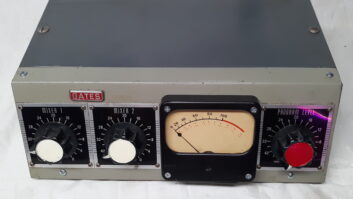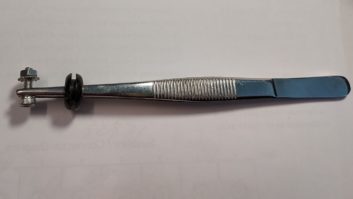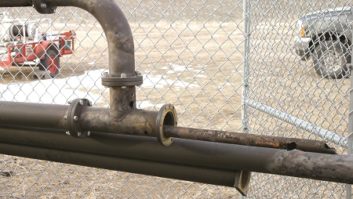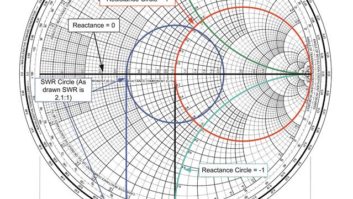Standing waves and antennas
Jan 1, 2003 12:00 PM, By John Battison, P.E., technical editor, RF
Maximum transmission efficiency occurs when the load impedance matches the generator impedance. Engineers do this to eliminate standing waves, which can severely damage equipment.
Transmission lines in AM stations are more likely to be mismatched than those in FM transmitters. In FM, the desired transmitter-to-antenna match is accomplished using pre-established standard antenna and transmission line impedances that are designed to match each other, and separate antenna tuning units are not required. Most FM antennas provide some form of final tuning and adjustment to be made once the antenna is installed on its tower. When problems of abnormal VSWR occur, they generally result from mechanical or electrical damage due to the transmission line or antenna, and frequently to heavy ice formation on the antenna. When ice is allowed to build up the VSWR increases and the protection circuit trips the transmitter before any serious damage can occur.
The view in general
FM engineers are likely to experience more severe VSWR problems than AM engineers. Almost every FM transmitter has a built-in VSWR meter associated with a protection circuit to turn the transmitter off if the VSWR becomes excessive. The considerably higher operating frequency, and consequently shorter wavelength, means that path lengths can become critical and it is easier to develop unexpected standing waves.

Figure 1. The voltage nulls appear at half-wavelength points, coinciding with the short in the Lecher wire.
In AM work misadjustment of ATUs and other devices in the transmission line circuit can result in a severe mismatch that goes unnoticed. Sometimes a bad mismatch can exist for years in a nondirectional AM operation that has sufficient transmitter power output to overcome the losses produced by the mismatch. In AM operations, coaxial transmission lines normally have a 50O nominal impedance. However, other values can be used without diminishing antenna operating efficiency, because the ATU matches the transmission line impedance to the antenna impedance. VSWR, although important, is usually less critical in AM transmission than in FM, and a small amount is often tolerated without noticeable problems. Over the years as the ATUs and phasor are adjusted, small errors are often introduced and standing waves begin to occur, which can cause problems such as heating in the transmission line and ATU components.
Easier methods
Long before electronic frequency measuring devices, radio engineers had to measure frequency using Lecher wires, which amounted to a yardstick. There weren’t any pocket frequency meters that would tell show the frequency at the press of a button. Instead, it was necessary to measure the distance between the brightest (strongest) or the weakest (null) indications on a pair of long straight parallel wires supported on insulators and (transmission line) spaced two or three inches apart. The indicator was a neon bulb that tended to extinguish suddenly and made it difficult to find absolute nulls. Any simple indicator that does not load down the Lecher wires can be used. Areas of high voltage are normally quite broad while nulls are narrow. This is why the engineer should measure at the nulls.
Lecher wires provided a good understanding of standing wave ratios and their effects on antenna transmission lines. The basic principles demonstrated by the Lecher wires helped to develop high-power transmission lines. Early single-wire antenna connections soon gave way to balanced and unbalanced transmission lines, and eventually to coaxial cable.
Figure 1 shows a Lecher wire with the far end shorted. Zero volts appear at the far end. If the probe is moved back toward the origin, a maximum will be found one quarter wave back from the end. Moving on from the quarter wave, a null is found at a half-wavelength point. Moving a quarter wavelength farther will bring us to another maximum at a half wavelength point. The distance between two maxima, or two nulls is a half wavelength. Multiplying this distance by two gives the distance for one full wavelength. From this we can calculate the frequency by converting to kilohertz. The reflection coefficient is -1 because the signal is completely reflected back and there is no power absorbed in the short.
When a signal reaches the short circuit a certain amount of signal will be reflected back and the remainder dissipated in the short if there is dissipative resistance. The phase of the reflected signal is controlled by the coefficient of reflection.
Figure 2 shows the effect of an open circuit at the receiving end. The receive end voltage is maximum. Measuring between two adjacent nulls shows a half wavelength. In the case of an open circuit, or a short circuit, no energy is taken from the line (provided there is no dissipative resistance). Instead, the signal is reflected back in the opposite direction. Because the reflected signal has the same amplitude and phase as the outgoing wave, both voltages are added and the voltage is at a maximum at the open end.

Figure 2. With the short in the Lecher wire removed, a high voltage appears at the open end.
Should the line be terminated by a reactance that has absolutely no resistance, no power will be absorbed in the receiver end or load. In the case of a high-powered transmitter this could have disastrous effects. Putting power into a line that is not terminated will have the same effect because in both cases there is no resistance across the terminal, and the transmitter could be badly damaged by the high voltages developed.
If a line is not correctly terminated the outgoing and reflected waves will pass each other, going in opposite directions. The two voltages will add in some places and subtract at others, and the resulting voltage will be lower or higher than the original signal. Because the two signals go in opposite directions and at the same speed, the nulls and the maxima will not move around but will stay in fixed positions. This produces the familiar and sometimes troublesome standing wave.
An RF transmission line is not an ordinary circuit. AM lines should never have problems with delay effects because the longer wavelengths of the AM frequencies are large compared to the dimensions of items that can cause delay. Delays are caused by the finite time required when energy moves along a transmission line.
E-mail John Battison at[email protected].











